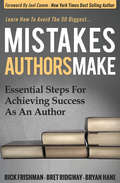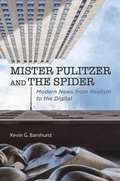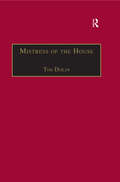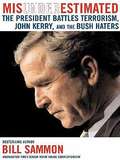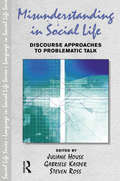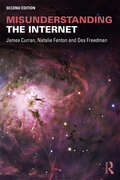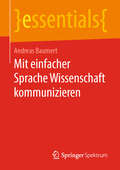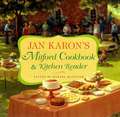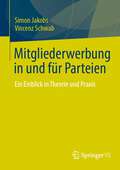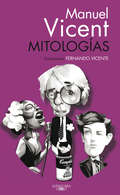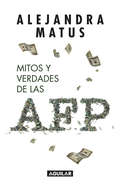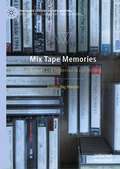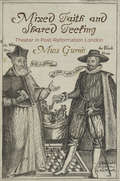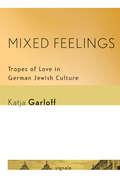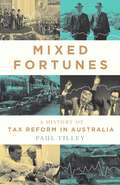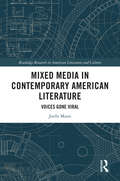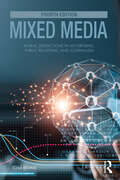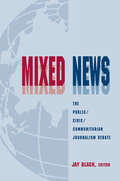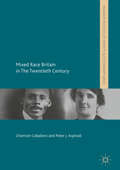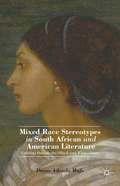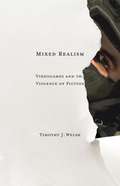- Table View
- List View
Mississippi Poets: A Literary Guide
by Catharine Savage BrosmanMississippi has produced outstanding writers in numbers far out of proportion to its population. Their contributions to American literature, including poetry, rank as enormous. Mississippi Poets: A Literary Guide showcases forty-seven poets associated with the state and assesses their work with the aim of appreciating it and its place in today’s culture. In Mississippi, the importance of poetry can no longer be doubted. It partakes, as Faulkner wrote, of the broad aim of all literature: “to uplift man’s heart.” In Mississippi Poets, author Catharine Savage Brosman introduces readers to the poets themselves, stressing their versatility and diversity. She describes their subject matter and forms, their books, and particularly representative or striking poems. Of broad interest and easy to consult, this book is both a source of information and a showcase. It highlights the organic connection between poetry by Mississippians and the indigenous music genres of the region, blues and jazz. No other state has produced such abundant and impressive poetry connected to these essential American forms.Brosman profiles and assesses poets from the twentieth and twenty-first centuries. Grounds for selection include connections between the poets and the state; the excellence and abundance of their work; its critical reception; and both local and national standing. Natives of Mississippi and others who have resided here draw equal consideration. As C. Liegh McInnis observed, “You do not have to be born in Mississippi to be a Mississippi writer. . . . If what happens in Mississippi has an immediate and definite effect on your work, you are a Mississippi writer.”
Mistakes Authors Make: Essential Steps for Achieving Success as an Author
by Rick Frishman Bret Ridgway Bryan Hane&“Features 50 of the most common errors book authors make in writing, publishing, and promoting their books.&” —John Kremer, author of 1001 Ways to Market Your Books The publishing landscape can be a tricky one to navigate. There are so many aspects to authoring and publishing a book that it&’s easy for you to make critical mistakes that can set you off course and significantly decrease your chances for success. How many of the 50 biggest author mistakes are you making? When you learn to avoid them, you can greatly enhance your chances for success in the publishing world. In this insider&’s look at the worlds of publishing and book marketing coauthors Rick Frishman, Bret Ridgway, and Bryan Hane bring their 65 combined years of experience in the publishing world to you and share their secrets to success. You&’ll learn: How to master media and other key marketing channels authors should useKeys to capturing the browsing buyer in bookstores and onlineThe new publishing landscape and how it impacts youHow to increase the readability of your book so readers keep coming backHow your book is the key piece of your own information marketing empireAnd much, much more &“If you want to write a book or make sure that your book is a smashing success read this now and take action! You&’ll be amazed at the difference it will make in your success!&” —John Assaraf, New York Times–bestselling author of Innercise and The Answer &“I LOVE the book so far! Clear-concise-comprehensive with practical info the aspiring author needs!&” —Laura Venecia Rodriguez, author of Yoga at Home
Mister Pulitzer and the Spider: Modern News from Realism to the Digital
by Kevin G BarnhurstA spidery network of mobile online media has supposedly changed people, places, time, and their meanings. A prime case is the news. Digital webs seem to have trapped "legacy media," killing off newspapers and journalists' jobs. Did news businesses and careers fall prey to the digital "Spider"? To solve the mystery, Kevin Barnhurst spent thirty years studying news going back to the realism of the 1800s. The usual suspects--technology, business competition, and the pursuit of scoops--are only partly to blame for the fate of news. The main culprit is modernism from the "Mister Pulitzer" era, which transformed news into an ideology called "journalism." News is no longer what audiences or experts imagine. Stories have grown much longer over the past century and now include fewer events, locations, and human beings. Background and context rule instead. News producers adopted modernism to explain the world without recognizing how modernist ideas influence the knowledge they produce. When webs of networked connectivity sparked a resurgence in realist stories, legacy news stuck to big-picture analysis that can alienate audience members accustomed to digital briefs.
Mistress of the House: Women of Property in the Victorian Novel (The Nineteenth Century Series)
by Tim DolinThis exploration of gender and property ownership in eight important novels argues that property is a decisive undercurrent in narrative structures and modes, as well as an important gender signature in society and culture. Tim Dolin suggests that the formal development of nineteenth-century domestic fiction can only be understood in the context of changes in the theory and laws of property: indeed femininity and its representation cannot be considered separately from property relations and their reform. He presents original readings of novels in which a woman owns, acquires or loses property, focusing on exchanges between patriarchal cultural authority, the 'woman question' and narrative form, and on the place of domestic fiction in a culture in which property relations and gender relations are subject to radical review. Each chapter revolves around a representative text, but refers substantially to other material, both other novels and contemporary social, legal, political and feminist commentary.
Misunderestimated: The President Battles Terrorism, John Kerry, and the Bush Haters
by Bill SammonConservative political analyst offers his opinions on the Bush presidency with a focus on foreign policy. Includes exclusive interviews with the president and his advisers.
Misunderstanding in Social Life: Discourse Approaches to Problematic Talk (Language In Social Life)
by Gabriele Kasper Juliane House Steven RossMisunderstanding is a pervasive phenomenon in social life, sometimes with serious consequences for people's life chances. Misunderstandings are especially hazardous in high-stakes events such as job interviews or in the legal system. In unequal power encounters, unsuccessful communication is regularly attributed to the less powerful participant, especially when those participants are members of an ethnic minority group. But even when communicative events are not prestructured by participants' differential positions in social hierarchies, misunderstandings occur at different levels of interactional and social engagement. Misunderstanding in Social Life examines such problematic talk in ordinary conversation and different institutional settings, including socializing events and story tellings, education and assessment activities, and interviews in TV news broadcasts, employment agencies, legal settings, and language testing. The analyzed interactions are located in a variety of sociocultural environments and conducted in a range of languages, including English, French, German, Hebrew, Japanese, such language varieties as Aboriginal Australian English and Maori New Zealand English, and nonnative varieties. The original studies included in this volume adopt a variety of theoretical perspectives, including discourse-pragmatic approaches, conversation analysis, interactional sociolinguistics, social constructionism, tropological and narrative analysis. They represent multiple views of misunderstanding as a multilayered discourse event.
Misunderstanding the Internet (Communication and Society)
by James Curran Des Freedman Natalie FentonThe growth of the internet has been spectacular. There are now more than 3 billion internet users across the globe, some 40 per cent of the world’s population. The internet’s meteoric rise is a phenomenon of enormous significance for the economic, political and social life of contemporary societies. However, much popular and academic writing about the internet continues to take a celebratory view, assuming that the internet’s potential will be realised in essentially positive and transformative ways. This was especially true in the euphoric moment of the mid-1990s, when many commentators wrote about the internet with awe and wonderment. While this moment may be over, its underlying technocentrism – the belief that technology determines outcomes – lingers on and, with it, a failure to understand the internet in its social, economic and political contexts. Misunderstanding the Internet is a short introduction, encompassing the history, sociology, politics and economics of the internet and its impact on society. This expanded and updated second edition is a polemical, sociologically and historically informed guide to the key claims that have been made about the online world. It aims to challenge both popular myths and existing academic orthodoxies that surround the internet.
Mit einfacher Sprache Wissenschaft kommunizieren (essentials)
by Andreas BaumertSchreiben für den fachfremden, gut ausgebildeten Leser: Worauf muss ein Autor achten? Was geschieht, wenn jemand einen Text versteht, wie kann man ihn dabei unterstützen? Was ist einfache Sprache in Wissenschaft und Technik? Wer eine Vorstellung vom Leser hat, kann auch für diesen schreiben. Mit einfacher Sprache, korrektem und stilistisch hochwertigem Deutsch unterstützt der Schreiber die Prozesse im Gehirn des Lesers. Dieses essential sieht das Arbeitsgedächtnis und seine Anbindung an das Langzeitgedächtnis als entscheidend für das Verstehen. Dessen Aufgaben können Autoren unterstützen und dem Leser so die Lektüre erleichtern. Einfache Sprache fällt dem Leser nur dadurch auf, dass er einen Text gut versteht. Voraussetzung ist immer, dass dieser Text für die Zielgruppe geschrieben ist, der ein Leser angehört.
Mitford Cookbook & Kitchen Reader
by Jan KaronThey say that once you learn to ride a bicycle, you never forget how to do it. The same principle, I've discovered, does not apply to cooking. Indeed, I was once a pretty good cook, but my skills have fallen on hard times-and a roast chicken is absolutely the very best I currently can do.
Mitgliederwerbung in und für Parteien: Ein Einblick in Theorie und Praxis
by Simon Jakobs Vincenz SchwabDas Buch fasst wesentliche Erkenntnisse zur Mitgliederwerbung in Parteien systematisch zusammen und gibt darüber hinaus praxisorientierte Tipps, wie sich Mitglieder optimal gewinnen lassen können. Dabei werden partizipationstheoretische, kommunikationspsychologische und nicht zuletzt linguistische Aspekte berücksichtigt. Die Publikation bietet sowohl einen fundierten Einblick in die Mitgliederwerbung von Parteien als auch eine praxistaugliche Handreichung für alle, die neue Mitglieder gewinnen wollen.
Mitologías
by Manuel VicentHéroes, mitos, leyendas literarias... Con gran fuerza expresiva y desde una mirada cáustica, Manuel Vicent demuestra de nuevo su maestría a la hora de realizar retratos literarios. El lector que se aventure en esta galería de retratos, Mitologías de Manuel Vicent, se hallará ante una serie de personajes excepcionales, magnéticos, pero de carne y hueso. En este recorrido alternativo por la historia de la creación literaria y artística, Manuel Vicent pasa del glamour de Andy Warhol a la desdicha de Cézanne o Billie Holliday. Artistas malditos, autodestructivos y abocados a un final trágico como Modigliani o Montgomery Clift contrastan con los que, como Billy Wilder o Sinatra, supieron controlar su destino y alcanzar la felicidad. La honestidad y el compromiso de personajes como Yves Montand o Zenobia Camprubí chocan con la doblez de personajes como el falsificador Van Meegeren o el espía doble Anthony Blunt...
Mitos y verdades de las AFP
by Alejandra Matus AcuñaUna indagación que destapa los mitos en torno al polémico sistema previsional chileno Alejandra Matus describe de modo ameno, didáctico, claro e irrebatible cómo es, fue y podría llegar a ser el sistema previsional chileno actual. A través de la revisión de documentos y entrevistas a expertos, usuarios y actores del sistema, irá desvelando los secretos del modelo que hoy tiene a los chilenos marchando en las calles. El libro quiere dilucidar múltiples preguntas que inquietan a los chilenos. ¿Por qué y en qué momento se crearon las AFP? Cómo era el antiguo sistema y si es verdad que estaba quebrado. Las transferencias del Estado a las AFP en el momento inicial. La oposición de Pinochet y el por qué los civiles envidiamos a los uniformados. El rol de José Piñera y cómo logró salirse con la suya. Las reformas, como se han fortalecido y las redes de poder que han sostenido el sistema. "Su investigación aborda temas cruciales, desde las críticas más duras hasta las posibles soluciones para mejorar las pensiones de los chilenos."
Mittens
by Barbara W. MakarA systematic, phonics-based early reading program that includes: the most practice for every skill, decodable readers for every skill, and reinforcement materials--help struggling students succeed in the regular classroom
Mix Tape Memories: Movement and Difference in Life Writing (Palgrave Studies in Life Writing)
by Anders Høg HansenThis book ‘plays up’ stories of mostly unknown figures and their journeys through a life affected by movement, and a search for home. It engages with individuals and groups whose passions have carried the subjects through ‘uncharted’ or unhomely territories, here told in a series of ‘tracks’ depicting their roles in community memories and histories. Side A engages with individual journeys, such as Lewis, the American black literature book seller; the civil rights activist, Izzy, an American-Swedish folklorist; Eugene, a black classical pianist; and Pi, the Jew transported to Sweden during WWII. Side B focuses on communal histories and alternative educational and artistic spaces, addressing life writing and memory in German comic books; alternative educational spaces in Israel-Palestine and Africa, and ‘small press passions’ of zines/newsletter culture. Tellers and their interpreters are mediating identities where nationality, race, and class (and other markers of identity) have influenced selfhood and collective belonging - revealing how individuals and outsider cultures have the power to influence dominant cultures and inspire societal change.
Mixed Categories: The Morphosyntax of Noun Modification (Cambridge Studies in Linguistics #164)
by Andrew Spencer Irina NikolaevaExploring the phenomenon of 'mixed categories', this book is the first in-depth study of the way in which languages can use a noun, as opposed to an adjective, to modify another noun. It investigates noun-adjective hybrids - adjectives and adjective-like attributive forms which have been derived from nouns and systematically retain certain nominal properties. These rarely-discussed types of mixed category raise a number of important theoretical questions about the nature of lexemic identity, the inflection-derivation divide, and more generally, the relationship between the structure of words and their phrasal syntax. The book proposes a new formal framework that models cross-linguistic and cross-constructional variation in noun modification constructions. The framework it offers enables readers to explicitly map word structure to syntactic structure, providing new insights into, and impacting upon, all current theoretical models of grammar.
Mixed Faith and Shared Feeling: Theater in Post-Reformation London
by Musa GurnisMixed Faith and Shared Feeling explores the mutually generative relationship between post-Reformation religious life and London's commercial theaters. It explores the dynamic exchange between the imaginatively transformative capacities of shared theatrical experience, with the particular ideological baggage that individual playgoers bring into the theater. While early modern English drama was shaped by the polyvocal, confessional scene in which it was embedded, Musa Gurnis contends that theater does not simply reflect culture but shapes it. According to Gurnis, shared theatrical experience allowed mixed-faith audiences to vicariously occupy alternative emotional and cognitive perspectives across the confessional spectrum.In looking at individual plays, such as Thomas Middleton's A Game of Chess and Shakespeare's Measure for Measure, Gurnis shows how theatrical process can restructure playgoers' experiences of confessional material and interrupt dominant habits of religious thought. She refutes any assumption that audiences consisted of conforming Church of England Protestants by tracking the complex and changing religious lives of seventy known playgoers. Arguing against work that seeks to draw fixed lines of religious affiliation around individual playwrights or companies, she highlights the common practice of cross-confessional collaboration among playhouse colleagues. Mixed Faith and Shared Feeling demonstrates how post-Reformation representational practices actively reshaped the ways ideologically diverse Londoners accessed the mixture of religious life across the spectrum of beliefs.
Mixed Feelings: Tropes of Love in German Jewish Culture (Signale: Modern German Letters, Cultures, and Thought)
by Katja GarloffSince the late eighteenth century, writers and thinkers have used the idea of love—often unrequited or impossible love—to comment on the changing cultural, social, and political position of Jews in the German-speaking countries. In Mixed Feelings, Katja Garloff asks what it means for literature (and philosophy) to use love between individuals as a metaphor for group relations. This question is of renewed interest today, when theorists of multiculturalism turn toward love in their search for new models of particularity and universality. Mixed Feelings is structured around two transformative moments in German Jewish culture and history that produced particularly rich clusters of interfaith love stories. Around 1800, literature promoted the rise of the Romantic love ideal and the shift from prearranged to love-based marriages. In the German-speaking countries, this change in the theory and practice of love coincided with the beginnings of Jewish emancipation, and both its supporters and opponents linked their arguments to tropes of love. Garloff explores the generative powers of such tropes in Moses Mendelssohn, G. E. Lessing, Friedrich Schlegel, Dorothea Veit, and Achim von Arnim. Around 1900, the rise of racial antisemitism had called into question the promises of emancipation and led to a crisis of German Jewish identity. At the same time, Jewish- Christian intermarriage prompted public debates that were tied up with racial discourses and concerns about procreation, heredity, and the mutability and immutability of the Jewish body. Garloff shows how modern German Jewish writers such as Arthur Schnitzler, Else Lasker-Schüler, and Franz Rosenzweig wrest the idea of love away from biologist thought and reinstate it as a model of sociopolitical relations. She concludes by tracing the relevance of this model in post-Holocaust works by Gershom Scholem, Hannah Arendt, and Barbara Honigmann.
Mixed Feelings: Tropes of Love in German Jewish Culture (Signale: Modern German Letters, Cultures, and Thought)
by Katja GarloffSince the late eighteenth century, writers and thinkers have used the idea of love—often unrequited or impossible love—to comment on the changing cultural, social, and political position of Jews in the German-speaking countries. In Mixed Feelings, Katja Garloff asks what it means for literature (and philosophy) to use love between individuals as a metaphor for group relations. This question is of renewed interest today, when theorists of multiculturalism turn toward love in their search for new models of particularity and universality. Mixed Feelings is structured around two transformative moments in German Jewish culture and history that produced particularly rich clusters of interfaith love stories. Around 1800, literature promoted the rise of the Romantic love ideal and the shift from prearranged to love-based marriages. In the German-speaking countries, this change in the theory and practice of love coincided with the beginnings of Jewish emancipation, and both its supporters and opponents linked their arguments to tropes of love. Garloff explores the generative powers of such tropes in Moses Mendelssohn, G. E. Lessing, Friedrich Schlegel, Dorothea Veit, and Achim von Arnim. Around 1900, the rise of racial antisemitism had called into question the promises of emancipation and led to a crisis of German Jewish identity. At the same time, Jewish- Christian intermarriage prompted public debates that were tied up with racial discourses and concerns about procreation, heredity, and the mutability and immutability of the Jewish body. Garloff shows how modern German Jewish writers such as Arthur Schnitzler, Else Lasker-Schüler, and Franz Rosenzweig wrest the idea of love away from biologist thought and reinstate it as a model of sociopolitical relations. She concludes by tracing the relevance of this model in post-Holocaust works by Gershom Scholem, Hannah Arendt, and Barbara Honigmann.
Mixed Fortunes: A History of Tax Reform in Australia
by Paul TilleyAustralia's history is sprinkled with attempts at tax reform - some successful, some not. Mixed Fortunes explores these efforts at substantive change in our tax system. Paul Tilley takes us from the establishment of the Australian Constitution at Federation in 1901 and the 1942 unification of income tax, through the seminal Asprey review in 1975 that set up the major tax reforms of the 1980s and 1990s, and up to the lack of tax reform, at both the Commonwealth and state levels, this century. Mixed Fortunes examines the roles of foundational reviews, which establish the case for reform, and determinative reviews, which implement reform. It assesses both the political economy issues of policymaking and the quality of the tax reforms that have been achieved in Australia. The key questions it addresses include: What makes a reform exercise work - or not? How do we assess the quality of Australia's tax reforms? And what lessons can be drawn from these experiences to help shape future tax reform exercises?
Mixed Media in Contemporary American Literature: Voices Gone Viral (Routledge Research in American Literature and Culture)
by Joelle MannMixed Media in Contemporary American Literature: Voices Gone Viral investigates the formation and formulation of the contemporary novel through a historical analysis of voice studies and media studies. After situating research through voices of nineteenth- and twentieth-century American literature, this book examines the expressions of a multi-media vocality, examining the interactions among cultural polemics, aesthetic forms, and changing media in the twenty-first century. The novel studies shown here trace the ways in which the viral aesthetics of the contemporary novel move language out of context, recontextualizing human testimony by galvanizing mixed media forms that shape contemporary literature in our age of networks. Through readings of American authors such as Claudia Rankine, David Foster Wallace, Jennifer Egan, Junot Díaz, Michael Chabon, Joseph O’Neill, Michael Cunningham, and Colum McCann, the book considers how voice acts as a site where identities combine, conform, and are questioned relationally. By listening to and tracing the spoken and unspoken voices of the novel, the author identifies a politics of listening and speaking in our mediated, informational society.
Mixed Media: Moral Distinctions in Advertising, Public Relations, and Journalism
by Tom Bivins Thomas BivinsMixed Media offers students of journalism, advertising, and public relations the tools for making ethical and moral decisions within their professional disciplines. The fourth edition of this popular text features more recent ethical theories that acknowledge and address intersectionality within the communicative landscape, including issues of gender, race, ability, and age. The author also takes into account today’s rapidly expanding technology, touching on subjects such as free speech, censorship, cancel culture, and misinformation, and considers how each of these is affected by online and social media. Other updates to the text include expanded coverage of citizen journalism, the increasing media use of artificial intelligence and virtual reality, power in communicative structures, and public interest, as well as refreshed examples throughout. As in previous editions of the book, special attention is paid to key ethical decision-making approaches and concerns in each media industry, including but not limited to truth telling, constituent obligations, persuasion versus advocacy, and respect for the consumers of public communication. Mixed Media is key reading for students of all branches of Media and Communication Ethics. The author's own website, featuring lecture notes, case studies and links to further reading, can be accessed at www.j397mediaethics.weebly.com.
Mixed News: The Public/civic/communitarian Journalism Debate (Routledge Communication Series)
by Jay BlackThis volume addresses some of the central issues of journalism today -- the nature and needs of the individual versus the nature and needs of the broader society; theories of communitarianism versus Enlightenment liberalism; independence versus interdependence (vs. co-dependency); negative versus positive freedoms; Constitutional mandates versus marketplace mandates; universal ethical issues versus situational and/or professional values; traditional values versus information age values; ethics of management versus ethics of worker bees; commitment and compassion versus detachment and professional "distance;" conflicts of interest versus conflicted disinterest; and "talking to" versus "talking with." All of these issues are discussed within the framework of the frenetic field of daily journalism--a field that operates at a pace and under a set of professional standards that all but preclude careful, systematic examinations of its own rituals and practices. The explorations presented here not only advance the enterprise, but also help student and professional observers to work through some of the most perplexing dilemmas to have faced the news media and public in recent times. This lively volume showcases the differing opinions of journalistic experts on this significant contemporary issue in public life. Unlike previous books and monographs which have tended toward unbridled enthusiasm about public journalism, and trade press articles which have tended toward pessimism, this book offers strong voices on several sides of this complex debate. To help inform the debate, a series of "voices"--journalistic interviews with practitioners and critics of public journalism -- is interspersed throughout the text. At the end of each essay, a series of quotes from a wide variety of sources -- "In other words..." -- augments each chapter with ideas and insights that support and contradict the points used by each chapter author.
Mixed Race Britain in The Twentieth Century (Palgrave Politics Of Identity And Citizenship)
by Peter J. Aspinall Chamion CaballeroThis book explores the overlooked history of racial mixing in Britain during the course of the twentieth century, a period in which there was considerable and influential public debate on the meanings and implications of intimately crossing racial boundaries. Based on research that formed the foundations of the British television series Mixed Britannia, the authors draw on a range of firsthand accounts and archival material to compare ‘official’ accounts of racial mixing and mixedness with those told by mixed race people, couples and families themselves. Mixed Race Britain in The Twentieth Century shows that alongside the more familiarly recognised experiences of social bigotry and racial prejudice there can also be glimpsed constant threads of tolerance, acceptance, inclusion and ‘ordinariness’. It presents a more complex and multifaceted history of mixed race Britain than is typically assumed, one that adds to the growing picture of the longstanding diversity and difference that is, and always has been, an ordinary and everyday feature of British life.
Mixed Race Stereotypes in South African and American Literature
by Diana Adesola MafeAmerica's new millennial interest in multiraciality coincides with South Africa's postapartheid push towards greater visibility as the Rainbow Nation. Here, Diana Adesola Mafe argues that the recent celebration of the mulatto as an avatar of positive change for multiracial nations like South Africa and the United States overlooks the complex global trajectories that resulted in this watershed moment. Mixed Race Stereotypes in South African and American Literature examines the popular literary stereotype, the tragic mulatto, from a comparative perspective. Mafe considers the ways in which specific South African and American writers have used this controversial literary character to challenge the logic of racial categorization. The result is a transnational dialogue between these respective national literatures, both of which use tragic mulatto fiction as a locus for broader questions about race and belonging.
Mixed Realism: Videogames and the Violence of Fiction (Electronic Mediations #50)
by Timothy J. WelshMixed Realism is about how we interact with media. Timothy J. Welsh shows how videogames, like novels, both promise and trouble experiences of &“immersion.&” His innovative methodology offers a new understanding of the expanding role of virtuality in contemporary life. Today&’s wired culture is a mixed reality, conducted as exchanges between virtual and material contexts. We make balance transfers at an ATM, update Facebook timelines, and squeeze in sessions of Angry Birds on the subway. However, the &“virtual&” is still frequently figured as imaginary, as opposed to &“real.&” The vision of 1990s writers of a future that would pit virtual reality against actual reality has never materialized, yet it continues to haunt cultural criticism. Our ongoing anxiety about immersive media now surrounds videogames, especially &“shooter games,&” and manifests as a fear that gamers might not know the difference between the virtual world and the real world.As Welsh notes, this is the paradox of real virtuality. We understand that the media-generated virtualities that fill our lives are not what they represent. But what are they if they are not real? Do they have presence, significance, or influence exceeding their material presence and the user processes that invoke them? What relationships do they establish through and beyond our interactions with them?Mixed Realism brims with fresh analyses of literary works such as Truman Capote&’s In Cold Blood and Mark Z. Danielewski&’s House of Leaves, along with sustained readings of controversial videogames such as Super Columbine Massacre and Call of Duty: Modern Warfare 2. Continually connecting the dots between surprising groupings of texts and thinkers, from David Foster Wallace to the cult-classic videogame Eternal Darkness and from Cormac McCarthy to Grand Theft Auto, it offers a fresh perspective on both digital games and contemporary literature.

